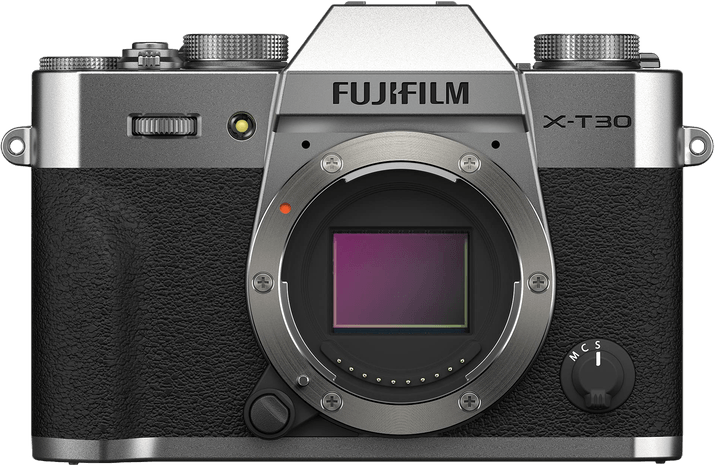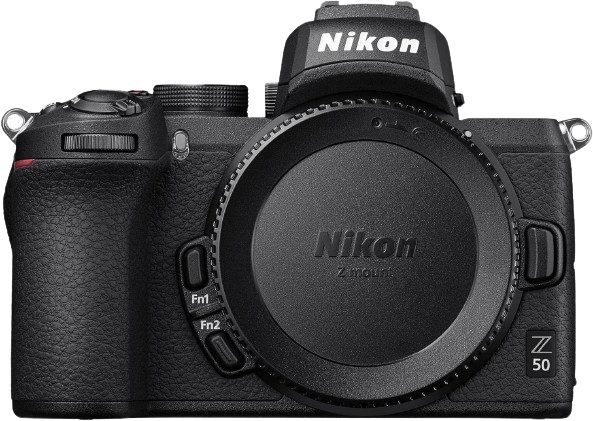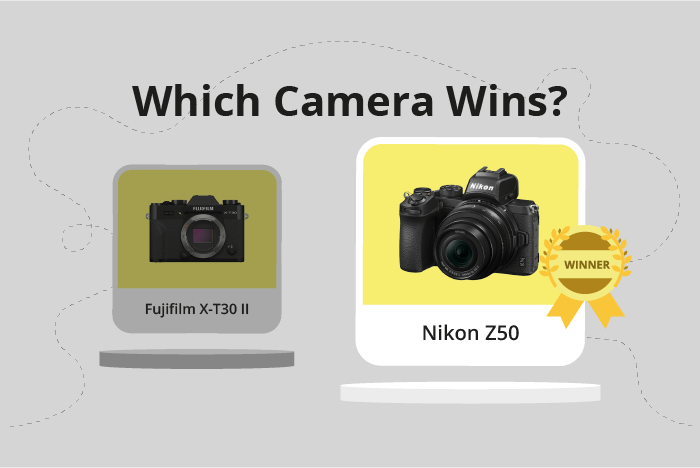Fujifilm X-T30 II vs Nikon Z50 Comparison
Fujifilm X-T30 II

Nikon Z50

The Nikon Z50 takes the lead with a score of 73/100, while the Fujifilm X-T30 II trails behind at 65/100. Both mirrorless cameras share similarities, such as their release years and comparable launch prices ($859 for the Nikon Z50 and $899 for the Fujifilm X-T30 II).
The Nikon Z50 outshines the Fujifilm X-T30 II with its larger dimensions (127 x 94 x 60mm) and slightly heavier weight (450g / 0.99lbs), which may contribute to its better performance and higher score. On the other hand, the Fujifilm X-T30 II has a more compact size (118 x 83 x 47mm) and lighter weight (383g / 0.84lbs), making it a more portable option for those prioritizing ease of travel and handling.
Ultimately, the Nikon Z50’s higher score reflects its superior performance, while the Fujifilm X-T30 II offers a more compact and lightweight alternative for users with different priorities.
Fujifilm X-T30 II vs Nikon Z50 Overview and Optics
The Nikon Z50 outperforms the Fujifilm X-T30 II in optics with a score of 72/100 compared to 67/100. Both cameras share some common specifications, including a CMOS sensor, APS-C sensor size, and lack of image stabilization. They also have their respective lens mounts: Fujifilm X for the X-T30 II and Nikon Z for the Z50.
The Nikon Z50 has a clear advantage in several areas. Although it has a lower megapixel count of 21 compared to the X-T30 II’s 26, it compensates with a higher shooting speed of 11 frames per second (fps) versus the Fujifilm’s 30 fps. The Z50 is equipped with the Expeed 6 processor, which contributes to its superior optics score. Additionally, the Z50’s sensor has a DXOMARK score of 97, a valuable metric for image quality, whereas Fujifilm cameras are not scored by DXOMARK.
On the other hand, the Fujifilm X-T30 II offers higher megapixels, resulting in more detailed images. However, this advantage is offset by the lower shooting speed and the absence of a DXOMARK score. The X-T30 II uses the X-Processor 4, which, while not as powerful as the Z50’s Expeed 6, still delivers quality images.
Given these factors, the Nikon Z50 emerges as the better camera in terms of optics. Its superior shooting speed, Expeed 6 processor, and impressive DXOMARK score outweigh the higher megapixel count of the Fujifilm X-T30 II. While the X-T30 II produces more detailed images, the Z50 offers a more well-rounded performance in optics, making it the preferable choice for photographers seeking quality and speed.
Fujifilm X-T30 II vs Nikon Z50 Video Performance
The Fujifilm X-T30 II and the Nikon Z50 are tied in terms of video capabilities, each scoring 91/100. Both cameras share several common specifications, such as 4K max video resolution, 120fps max video frame rate, and built-in time-lapse functionality. Despite their equal scores, there are some differences between the two models that may influence a buyer’s decision.
The Fujifilm X-T30 II has a max video dimension of 4096 x 2160, which is larger than the Nikon Z50’s max video dimension of 3840 x 2160. This difference means that the X-T30 II can produce slightly higher resolution videos, providing more detail and better image quality. For videographers who prioritize resolution, the Fujifilm X-T30 II may be the better choice.
On the other hand, the Nikon Z50 does not have any significant advantages over the Fujifilm X-T30 II in terms of video capabilities. Both cameras offer the same frame rate and time-lapse features, making them equally suitable for capturing fast-moving action and creating stunning time-lapse videos.
Taking these factors into account, the Fujifilm X-T30 II comes out as a slightly better option for those who prioritize video resolution. Its larger max video dimensions give it an edge over the Nikon Z50 in terms of image quality. However, for users who do not require the highest possible resolution, both cameras offer similar video capabilities, making them equally suitable for a wide range of applications.
Fujifilm X-T30 II vs Nikon Z50 Features and Benefits
The Nikon Z50 emerges as the winner in the comparison of features, scoring 86 out of 100, while the Fujifilm X-T30 II scores 70 out of 100. Both cameras share several specifications, including a touchscreen, flip screen, 1,040,000-dot screen resolution, and the absence of GPS. Additionally, both cameras offer WIFI and Bluetooth connectivity options.
The Nikon Z50 outshines the Fujifilm X-T30 II in terms of screen size, as it has a larger 3.2-inch screen compared to the 3-inch screen on the Fujifilm X-T30 II. This larger screen provides users with a more comfortable and immersive experience when navigating menus, reviewing images, and composing shots.
Despite the overall higher feature score of the Nikon Z50, the Fujifilm X-T30 II still has its advantages. However, in this comparison, both cameras have identical features, making it difficult to pinpoint a specific area where the Fujifilm X-T30 II outperforms the Nikon Z50.
Based on the analysis of their features, the Nikon Z50 proves to be the superior camera due to its larger screen size, providing a more enjoyable user experience. Meanwhile, the Fujifilm X-T30 II offers a very similar set of features, but its smaller screen size makes it less advantageous compared to the Nikon Z50. Ultimately, the choice between these two cameras comes down to personal preference and brand loyalty, as both cameras offer a strong set of features suitable for various photography needs.
Fujifilm X-T30 II vs Nikon Z50 Storage and Battery
The Fujifilm X-T30 II and Nikon Z50 both score 35/100 in storage and battery. They share similar specifications in this category, with each camera having one memory card slot, accepting SD, SDHC, and SDXC (UHS-I compatible) cards. Both cameras also support USB charging.
The Fujifilm X-T30 II has a slight advantage in battery life, providing 380 shots per charge, compared to the Nikon Z50’s 320 shots. This longer battery life makes the X-T30 II more suitable for extended shooting sessions without needing frequent battery replacements or recharging.
On the other hand, the Nikon Z50 does not have any notable advantages over the Fujifilm X-T30 II in terms of storage and battery. Both cameras have the same score, indicating that they perform similarly in this aspect.
Considering the storage and battery specifications, the Fujifilm X-T30 II has a minor edge over the Nikon Z50 due to its longer battery life. However, both cameras are quite similar in this regard, and the difference may not be a deciding factor for most users.
Fujifilm X-T30 II vs Nikon Z50 – Our Verdict
Are you still undecided about which camera is right for you? Have a look at these popular comparisons that feature the Fujifilm X-T30 II or the Nikon Z50:

